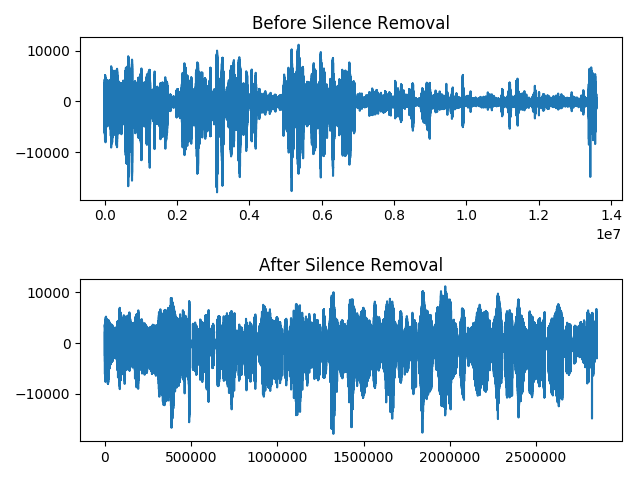MaxStrange / Audiosegment
Programming Languages
Projects that are alternatives of or similar to Audiosegment
AudioSegment
Wrapper for pydub AudioSegment objects. An audiosegment.AudioSegment object wraps a pydub.AudioSegment object. Any methods or properties it has, this also has.
Docs are hosted by GitHub Pages, but are currently hideous. I've got to do something about them as soon as I find some time. You can also try Read The Docs, though the docs there don't seem to be building for some reason.... also something I need to look into. Up-to-date docs are also built and pushed and are in the docs folder of this repository.
Notes
There is a hidden dependency on the command line program 'sox'. Pip will not install it for you. You will have to install sox by:
- Debian/Ubuntu:
sudo apt-get install sox - Mac OS X:
brew install sox - Windows:
choco install sox
Also, I use librosa and scipy, for some of the functionality. These dependencies are hefty, and I have decided to make them optional. If you do not install them, you may get warnings when using audiosegment.
So, a full installation on Debian/Ubuntu would like like this:
sudo apt-get install sox
pip3 install --user audiosegment
# To get scipy, you will need some lapack/blas resources:
sudo apt-get install libatlas-base-dev gfortran
pip3 install --user scipy
# To get librosa, you will need numba, which requires LLVMlite, which requires LLVM.
sudo apt-get install llvm
pip3 install --user librosa
Make suitable adjustments to fit your own OS's package management system.
TODO
The following is the list of items I plan on implementing.
- Finish implementing auditory scene analysis (a.k.a blind source separation)
- Add voice-pass filtering and make voice activity detection better
- Add language classification for English and Chinese (and show how to do it for other languages)
- Add more examples to README (especially filterbank)
- Finish removing the SOX dependency
I am open to other suggestions. Open an issue if you have requests, or better yet, if you can do it yourself and open a pull request, I'll take a look and merge in if I think it makes sense.
Example Usage
Basic information
import audiosegment
print("Reading in the wave file...")
seg = audiosegment.from_file("whatever.wav")
print("Information:")
print("Channels:", seg.channels)
print("Bits per sample:", seg.sample_width * 8)
print("Sampling frequency:", seg.frame_rate)
print("Length:", seg.duration_seconds, "seconds")
Voice Detection
# ...
print("Detecting voice...")
seg = seg.resample(sample_rate_Hz=32000, sample_width=2, channels=1)
results = seg.detect_voice()
voiced = [tup[1] for tup in results if tup[0] == 'v']
unvoiced = [tup[1] for tup in results if tup[0] == 'u']
print("Reducing voiced segments to a single wav file 'voiced.wav'")
voiced_segment = voiced[0].reduce(voiced[1:])
voiced_segment.export("voiced.wav", format="WAV")
print("Reducing unvoiced segments to a single wav file 'unvoiced.wav'")
unvoiced_segment = unvoiced[0].reduce(unvoiced[1:])
unvoiced_segment.export("unvoiced.wav", format="WAV")
Silence Removal
import matplotlib.pyplot as plt
# ...
print("Plotting before silence...")
plt.subplot(211)
plt.title("Before Silence Removal")
plt.plot(seg.get_array_of_samples())
seg = seg.filter_silence(duration_s=0.2, threshold_percentage=5.0)
outname_silence = "nosilence.wav"
seg.export(outname_silence, format="wav")
print("Plotting after silence...")
plt.subplot(212)
plt.title("After Silence Removal")
plt.tight_layout()
plt.plot(seg.get_array_of_samples())
plt.show()
FFT
import matplotlib.pyplot as plt
import numpy as np
#...
# Do it just for the first 3 seconds of audio
hist_bins, hist_vals = seg[1:3000].fft()
hist_vals_real_normed = np.abs(hist_vals) / len(hist_vals)
plt.plot(hist_bins / 1000, hist_vals_real_normed)
plt.xlabel("kHz")
plt.ylabel("dB")
plt.show()
Spectrogram
import matplotlib.pyplot as plt
#...
freqs, times, amplitudes = seg.spectrogram(window_length_s=0.03, overlap=0.5)
amplitudes = 10 * np.log10(amplitudes + 1e-9)
# Plot
plt.pcolormesh(times, freqs, amplitudes)
plt.xlabel("Time in Seconds")
plt.ylabel("Frequency in Hz")
plt.show()



